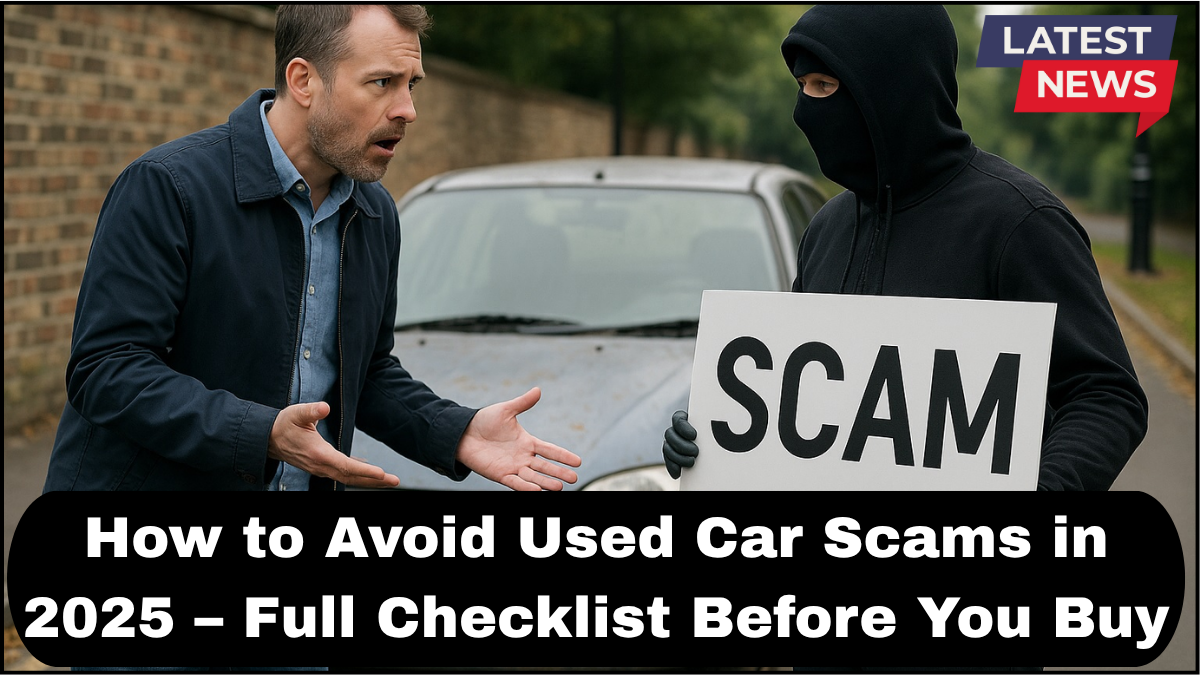Buying a used car in 2025 is more convenient than ever—but it’s also riskier if you don’t do your homework. With scammers becoming increasingly sophisticated, one wrong move can cost you thousands or even leave you with a stolen or tampered vehicle.
This guide gives you a full checklist to avoid used car scams in 2025, complete with actionable tips and smart strategies. Whether you’re buying from a dealer or a private seller, these checks will help you steer clear of fraud and get a car worth your money.

Inspect the Seller’s Legitimacy
Before anything else, verify who you’re dealing with.
-
Dealerships: Look up reviews, ratings, and certifications. Reputable dealers will have a physical address, business license, and a valid tax number.
-
Private Sellers: Ask for identification and match it to the name on the car’s registration. If the seller seems evasive or overly pushy, walk away.
Red Flag: If the seller refuses to meet in person or insists on a wire transfer before you’ve even seen the car, it’s likely a scam.How to Verify RC Ownership (Registration Certificate)
This is one of the most important steps.
-
Check the RC Book or Smart Card: Ensure it matches the seller’s name and address.
-
Use Official Portals: Platforms like VAHAN (India) or your local DMV’s digital services can verify ownership details using the registration number.
-
Engine and Chassis Numbers: Confirm these match the RC. Any mismatch could indicate tampering or theft.
Pro Tip: Ask for a copy of the seller’s ID and match it with the RC. It’s not enough for the name to match—make sure the photo ID is current and valid.
Get a Full Vehicle History Report
A thorough history report reveals more than the seller ever will.
Use services like Carfax, AutoCheck, or equivalent platforms in your country. These reports reveal:
-
Past accidents
-
Odometer rollback
-
Title issues (salvage, flood-damage, etc.)
-
Previous ownership details
-
Outstanding loans or liens
In 2025, more countries have centralized digital vehicle histories—take advantage of them.
Run a VIN Check (Vehicle Identification Number)
The VIN is your car’s DNA. It should be stamped in multiple locations on the vehicle:
-
Dashboard (near windshield)
-
Driver’s side door frame
-
Engine bay
Check for signs of tampering—sanded areas, mismatched fonts, or poorly reprinted stickers can mean foul play. Run the VIN through multiple databases to confirm it’s clean.
Inspect the Vehicle in Broad Daylight
Scammers often schedule viewings in poor lighting to hide flaws. Inspect:
-
Paint Consistency: Inconsistent paint may indicate prior accidents.
-
Panel Gaps: Uneven gaps can mean structural repairs.
-
Under the Hood: Look for leaks, corrosion, or signs of replaced parts.
-
Tires & Brakes: Uneven tire wear or squeaky brakes = potential money pit.
Bring a trusted mechanic if you’re not confident.
Take a Test Drive and Watch Behavior
A test drive isn’t just for performance—it’s for observation.
-
Does the engine start smoothly?
-
Are there unusual noises?
-
Does the steering pull to one side?
Also watch the seller’s behavior. Do they rush you? Avoid questions? Refuse a mechanic check? These are all signs of a potential used car scam in 2025.
Demand All Legal Documents
You must receive:
-
RC (Registration Certificate)
-
Pollution Under Control (PUC) certificate
-
Insurance papers
-
Original invoice
-
Road tax receipt
-
Service records
Make sure everything matches up, and insist on a signed sale agreement with both parties’ details clearly listed.
Be Cautious with Online Marketplaces
While sites like OLX, Craigslist, and Facebook Marketplace are flooded with car listings, they’re also hotspots for scams.
-
Avoid too-good-to-be-true prices.
-
Never pay a deposit without verifying the car.
-
Always meet in public or secure locations.
-
Use escrow services if possible.
Check for Loan Clearance
Some used cars have outstanding auto loans. If you buy without knowing, the bank can repossess the car.
-
Check the RC for hypothecation status.
-
Ask for a NOC (No Objection Certificate) from the financing company.
-
Call the bank directly to confirm clearance if needed.
Negotiate Smartly, But Don’t Be Naive
If the seller drops the price drastically after a lowball offer, be skeptical. They may be trying to offload a lemon. Do your own market research using platforms like CarDekho, Edmunds, or Kelley Blue Book.
FAQs About Used Car Scams in 2025
Q1: What’s the most common used car scam in 2025?
A: Odometer tampering and fake RC ownership are leading scams. Always cross-check digital records and never trust paper documents alone.
Q2: How can I verify RC ownership quickly?
A: Use the VAHAN portal (India) or your local transport department’s online services. Enter the registration number to view owner details instantly.
Q3: Is buying from a dealer safer than a private seller?
A: Not always. While dealers offer more structure, some may still engage in unethical practices. Always perform the same level of due diligence.
Q4: Can I trust online car listings?
A: Yes—but only after verifying every detail. Scammers often use stolen images and fake identities. Never pay or commit without a full inspection.
click here to learn more